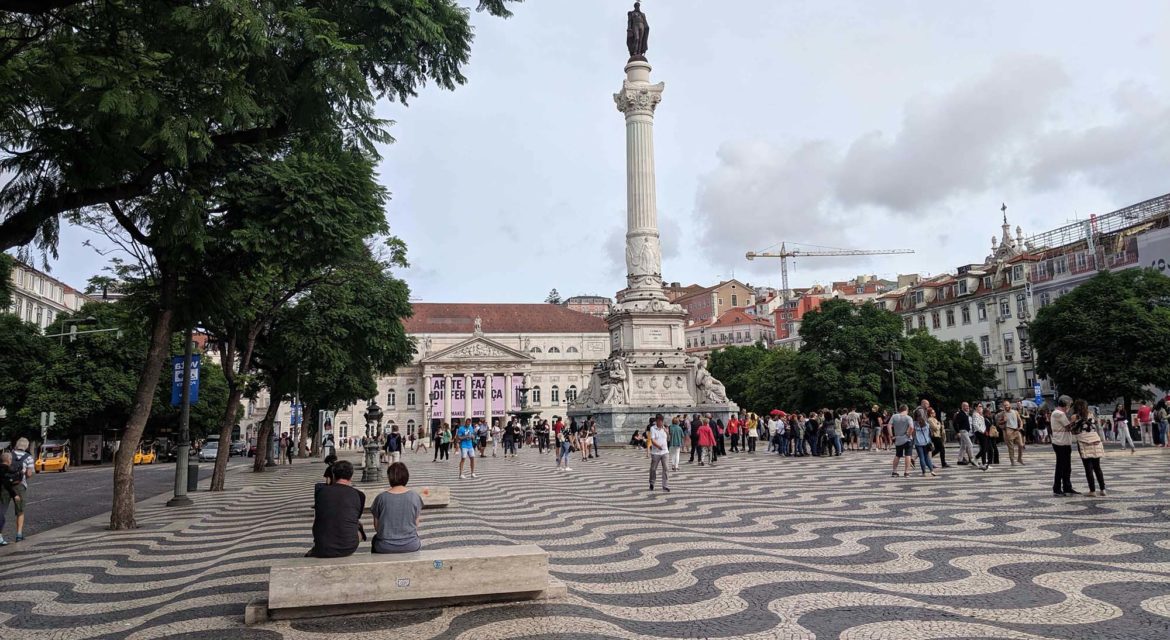 Officially named King Pedro IV Square (Praça Dom Pedro IV in Portuguese), the plaza better known as Rossio Square or Praça do Rossio in the Pombaline Downtown area of Lisbon has been a hub of activity for centuries. It remains one of the liveliest sections of Lisbon with famous shops and notable stores on every side. However, it’s the numerous features and attractions that have enabled it to create an identity that resonates across all of Portugal.
Officially named King Pedro IV Square (Praça Dom Pedro IV in Portuguese), the plaza better known as Rossio Square or Praça do Rossio in the Pombaline Downtown area of Lisbon has been a hub of activity for centuries. It remains one of the liveliest sections of Lisbon with famous shops and notable stores on every side. However, it’s the numerous features and attractions that have enabled it to create an identity that resonates across all of Portugal.

“The “Common Land” of Lisbon
The rough translation of Rossio means “common land” and the future Rossio Square first became an important place in Lisbon during the 13th and 14th centuries. It was even the setting for public executions in the 16th century. The All-Saints Royal Hospital, completed in 1504, dominated the square until the great 1755 Lisbon earthquake, which destroyed most of the buildings in the area. An effort to rebuild the square began in the second half of the 18th century and gave the square its current form.
 In the 19th century, the square was paved with cobblestones in wave patterns to resemble the oceans. This pattern has become uniquely identifiable with Rossio Square and can be seen in many other pavements all over Portugal and the rest of the world. In 1889, two large fountains that depict mythical figures were installed on the square. However, these identical fountains are not the most notable feature of Rossio Square.
In the 19th century, the square was paved with cobblestones in wave patterns to resemble the oceans. This pattern has become uniquely identifiable with Rossio Square and can be seen in many other pavements all over Portugal and the rest of the world. In 1889, two large fountains that depict mythical figures were installed on the square. However, these identical fountains are not the most notable feature of Rossio Square.
In the center of Rossio Square is the Column of Pedro IV of Portugal, which gives the space its official name. Known as “the Soldier King”, the monument was erected in 1870. The bronze statue of Pedro IV stands atop of a tall column, depicting him in a general’s uniform and royal cloak, holding the Constitutional Charter of 1826 in his right hand. Justice, Wisdom, Strength and Moderation, are represented by four female figures at the base of the pillar.
Two buildings dominate the modern square. The Dona Maria II National Theater was built in the 1840s and serves as the most notable building in Rossio Square. The monumental neoclassical building is crowned with a statue of playwright Gil Vicente who is known as the father of Portugal’s theatre. Nearby is the Rossio Railway Station, built in 1887. The unique horseshoe-shaped entrances provide the building and space with a distinct look and feel.
The design, monuments and buildings throughout Rossio Square have given the entire space a strong sense of identity. This sense of place has guided and enabled the activities that continue to attract the attention of residents and visitors.

Cafes, Tours and Icons
 Rossio Square and the nearby streets contain some of Lisbon’s most famous restaurants, bars and shops. Located within the sightline of the Column of Pedro IV, Café Nicola is one of the most famous coffee shops in all of Lisbon and has been open for hundreds of years. Nearby, Café Suiça is also located in Rossio Square and has become popular for its outdoor terrace.
Rossio Square and the nearby streets contain some of Lisbon’s most famous restaurants, bars and shops. Located within the sightline of the Column of Pedro IV, Café Nicola is one of the most famous coffee shops in all of Lisbon and has been open for hundreds of years. Nearby, Café Suiça is also located in Rossio Square and has become popular for its outdoor terrace.
Both residents and visitors have benefitted from Rossio Square becoming a popular gathering place for people to meet. After having been host to everything from revolts to celebrations to bullfights, Rossio Square continues to be an important gathering place for community activities that can be geared toward anyone. These events range from free walking tours to impromptu protests. Groups and tours often make Rossio Square the highlights of a trip and the proximity to other notable icons like the Praça do Comércio has further driven that popularity.
Rossio Square is constantly populated by locals and tourists, showcasing why it’s not only an important element of maps and souvenirs associated with Lisbon but also why that kind of popularity can be so important for an entire city and region.

The Most Lively Square in Lisbon
 With a history that few places can match, Rossio Square would always be a popular spot for people to congregate. However, like other squares that contain notable monuments and distinctive design elements, Rossio Square has created an identity that both residents and tourists actively engage with. That difference has enabled it to create a legacy that continues to benefit Lisbon and resonates across Portugal.
With a history that few places can match, Rossio Square would always be a popular spot for people to congregate. However, like other squares that contain notable monuments and distinctive design elements, Rossio Square has created an identity that both residents and tourists actively engage with. That difference has enabled it to create a legacy that continues to benefit Lisbon and resonates across Portugal.

